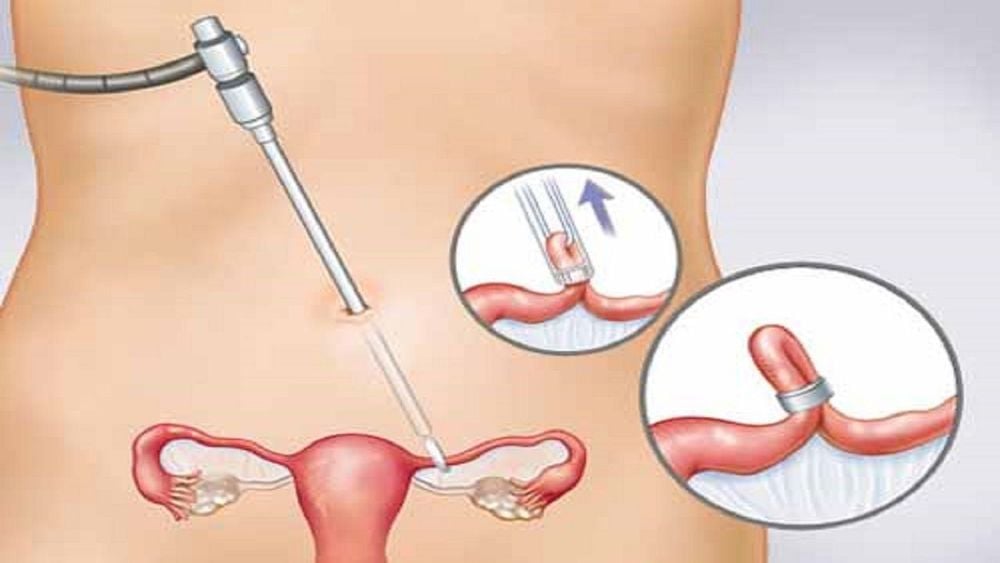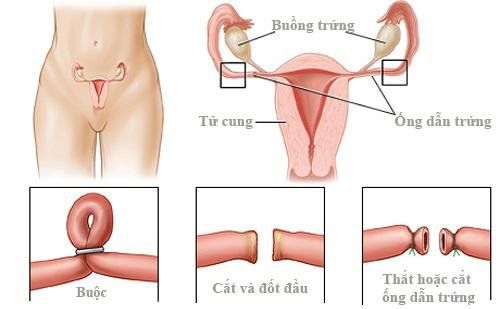This is an automatically translated article.
The article is professionally consulted by Master, Doctor Phung Quang Thuy - Department of Obstetrics and Gynecology - Vinmec Times City International Hospital.Tubal ligation is a permanent method of contraception in women. This is a small, simple surgery that is highly safe and effective for a lifetime. However, many women are still very worried when they hear advice about this method, fearing that it will affect their menstrual cycle later. Please refer to the information in the article below to understand more about this method.
1. What is tubal ligation?
Tubal ligation (Sterilization) is a method of preventing sperm and egg from meeting. There are many ways to block the fallopian tubes such as tying, burning, clamping, and ring.At that time, the endocrine role is because the ovary is responsible for the function of the ovary, still functioning as normal, excreting female sex hormones and nurturing, maturing eggs, ovulating, so physiology and menstruation are still intact. normal. Because the fallopian tubes are blocked, the egg cannot meet the sperm, so conception cannot occur.
2. When to choose tubal ligation?
Any woman can have this sterilization method if she has gone through a careful selection and consultation process.Sterilization is usually thought of for those over 30 years old, who have had two healthy, normally developing children, and the youngest child must be over 3 years old.
In addition, sterilization is appropriate in situations where the woman has serious medical conditions, is unable to become pregnant or has neuropsychiatric disorders.
Besides, contraindications such as being pregnant or suspected of being pregnant, having an acute infection of the genital area or the whole body, having an infection of the surgical site.
3. Consult before proceeding

This is a permanent method of contraception. Certain failure rate (1 in 10,000 pregnancies still after tubal ligation), increased risk of ectopic pregnancy. Complications caused by surgery itself (bleeding, infection...), although at a very low rate.
4. When and how to do it
The ideal time for tubal ligation is in the regenerative phase of the menstrual cycle, about day 5 to 10, avoiding the luteal phase is from day 14 to 28, for women with regular menstrual cycles 28 day.Tubal ligation is also sometimes combined with cesarean section. However, not because you want to be sterilized, but only by cesarean section because cesarean section itself also has risks for the mother and the fetus. In the postpartum period, from 24 to 36 hours after normal delivery, tubal ligation can also be performed because the fundus of the uterus is still at the level of the navel, making it easier to find the fallopian tubes, so only a small incision is needed. below the navel. At the same time, the time after surgery and postpartum happens at the same time at the hospital, creating convenient monitoring for doctors and pregnant women.
The day before surgery, the woman will have a general gynecological examination, test, do cervical smear and rule out menstrual disorders, tumors, genital prolapse, and urinary disorders. .
On the day of surgery, the woman will have an enema, catheterization and dressing change, and cleaning of the surgical site. Gynecologists can easily access the fallopian tubes by methods such as laparoscopy, small incisions on the lower abdomen or through the vagina. Fallopian tubes are blocked by electrocautery, ring tying, cutting and ligation...

5. Related Notes
Tubal ligation does not affect the menstrual cycle at all. Tubal ligation merely disrupts the continuity of the fallopian tubes and has no effect on the ovaries. Meanwhile, only the ovaries have an endocrine function, regulating the menstrual cycle. Sterilization also does not affect the feminine nature of a woman, in terms of temperament, skin, hair and even marital relations.Although this is a permanent method of contraception, it is not 100%. In some cases of ectopic pregnancy or intrauterine pregnancy, the fallopian tubes are able to reconnect spontaneously.
In summary, tubal ligation is an effective and safe method of contraception that does not affect the endocrine system. Both husband and wife need to be clear about this decision. At the same time, tubal ligation completely does not affect the menstrual cycle as well as the woman's health later on.
Please dial HOTLINE for more information or register for an appointment HERE. Download MyVinmec app to make appointments faster and to manage your bookings easily.














